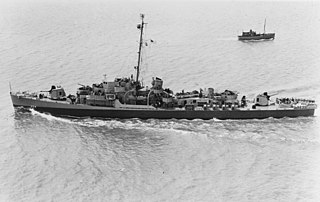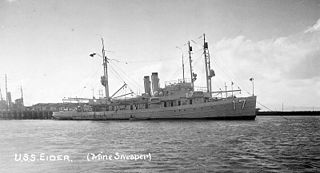
The first USS Warrington (DD-30) was a modified Paulding-class destroyer in the United States Navy during World War I. She was named for Lewis Warrington.
The first USS Duncan (DD-46) was a Cassin-class destroyer in the United States Navy during World War I. She was named for Commander Silas Duncan.

USS Rudderow (DE-224) was the lead ship of her class of destroyer escorts, in service with the United States Navy from 1944 to 1947. After spending decades in reserve, she was sold for scrap in 1970.

USS Greene (DD-266/AVD-13/APD-36) was a Clemson-class destroyer in the United States Navy in service from 1919 to 1922. She was recommissioned in 1940 and wrecked in a storm in October 1945.

The second USS Conestoga (SP-1128/AT-54) was an ocean-going tug in the United States Navy. Commissioned in 1917, it disappeared in the Pacific Ocean in 1921. The fate of the vessel was a mystery until its wreck was positively identified in 2016.

USS Mason (DE-529), an Evarts-class destroyer escort, was the second ship of the United States Navy to be named Mason, though DE-529 was the only one specifically named for Ensign Newton Henry Mason. USS Mason was one of two US Navy ships with largely African-American crews in World War II. The other was USS PC-1264, a submarine chaser. These two ships were manned by African Americans as the result of a letter sent to President Roosevelt by the NAACP in mid-December 1941. Entering service in 1944, the vessel was used for convoy duty in the Battle of the Atlantic for the remainder of the war. Following the war, Mason was sold for scrap and broken up in 1947.

USS Owl (AM-2) was an Lapwing-class minesweeper acquired by the U.S. Navy for the dangerous task of removing mines from minefields laid in the water to prevent ships from passing.

USS Grebe (AM-43) was a Lapwing-class minesweeper in the United States Navy.

USS Eider (AM-17) was a Lapwing-class minesweeper of the United States Navy.

USS Kewaydin (AT-24) was an Bagaduce-class fleet tug laid down for the U.S. Navy in the closing days of World War I and continued in operation throughout World War II.

USS Wadena (SP-158) was a converted yacht patrol vessel of the United States Navy during World War I. She was built in 1891 in Cleveland, Ohio, as a steam yacht for Jeptha Homer Wade II of Cleveland and New York City. During her Navy career, Wadena made several trips escorting submarine chasers across the Atlantic Ocean, and, later, patrolling in the Atlantic and Mediterranean. on 26 February 1918 Wadena came to the aid of sinking tug Mariner and rescued all of her crew.
USS SC-255, sometimes styled as either Submarine Chaser No. 255 or S.C.-255, was an SC-1-class submarine chaser built for the United States Navy during World War I. Like most members of her class, she was not named and known only by her designation.
USS SC-142, sometimes styled as either Submarine Chaser No. 142 or S.C.-142, was an SC-1-class submarine chaser built for the United States Navy during World War I. Upon completion, she was transferred to the French Navy

USS Lykens (SP-876/AT-56) was a steam tugboat purchased from the Reading Company by the United States Navy in 1917. Because she was privately built, she was not of a ship class. She was the only U.S. Navy ship of this name.
The first USS Barnegat (SP-1232) was a commercial tugboat acquired by the U.S. Navy during World War I. She was armed with a 3-inch gun and sent to Brest, France, to perform towing services for Allied ships. Post-war, she returned to the United States, was decommissioned, and was subsequently used on the Delaware River by the U.S. Army Corps of Engineers.

USS Concord (SP-773), later known as USS Mendota (YT-33) and again later as USS Muscotah (YT-33) was a tugboat acquired by the U.S. Navy during World War I. Concord was initially assigned to North Atlantic towing duties, and later was assigned as harbor tug at the Washington Navy Yard. She was sold in 1937.

USS Anderton (SP-530), originally to have been USS Raymond J. Anderton (SP-530), was a patrol vessel and minesweeper that served in the United States Navy from 1917 to 1919.

USS Goliah (SP-1494), also listed as ID-1494, was an armed tug that served in the United States Navy as a patrol vessel and tug from 1918 to 1919.

USS Sea Rover (SP-1014), later AT-57, was a United States Navy armed tug in commission from 1918 to 1921.

USS Arctic (SP-1158) was a wooden-hulled steam tug acquired by the US Navy during World War I. Arctic was briefly employed as a convoy escort during the war and later used to tow targets and transport ammunition. She was returned to commercial service in 1919.
















